Samsung Galaxy Note 10.1 (2014 Edition) Review
by Brian Klug & Anand Lal Shimpi on October 1, 2013 9:00 AM EST- Posted in
- Tablets
- Samsung
- Mobile
- Galaxy Note 10.1
Display
The 2014 Edition features a 10.1-inch 2560 x 1600 Super LCD display. Looking at the subpixel structure of the panel we get an idea for exactly what Super LCD means: RB,GW.
Instead of a standard RGB stripe we get a combination of red, green, blue and white subpixels for each pixel. The white subpixel helps increase light throughput, an obvious problem with these ultra high resolution displays. The downside is that you get a lower subpixel density than a traditional RGB stripe. At these ultra high pixel densities however, the theory is that you wouldn’t notice the difference - hopefully making the power savings by having better light transmission, particularly when displaying lots of white (e.g. web pages), worth it.
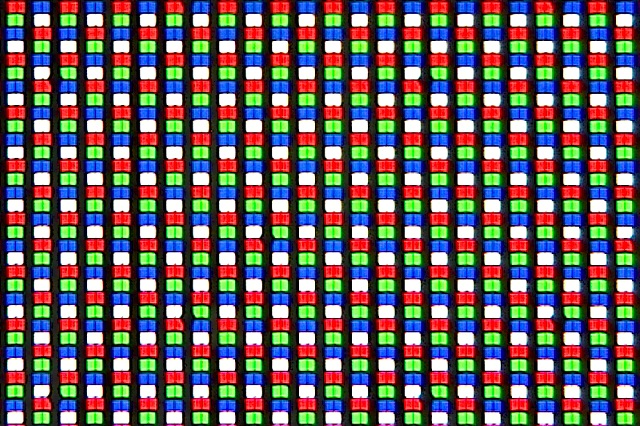
In practice the display looks pretty good, although a carefully trained eye will be able to recognize that this isn’t a standard RGB stripe. I quickly realized something was different about the display, something I later verified when looking at the subpixel structure.
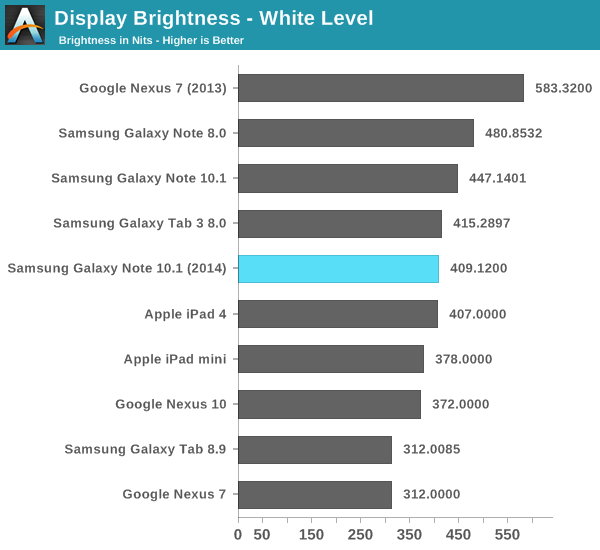
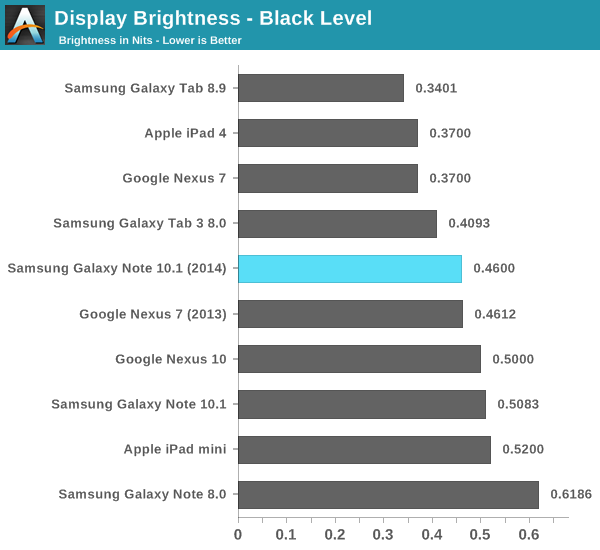
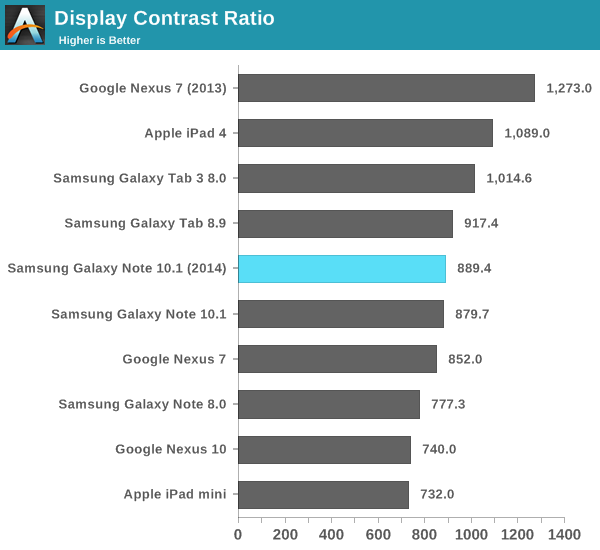
Color accuracy is pretty decent on the Note 10.1’s display. As always I’m reporting color data using Samsung’s Movie mode, which remains the most accurate setting of those offered. Grayscale performance is excellent, but our GMB and saturations tests put the Note 10.1 on par with the original Nexus 7. It’s definitely a better calibrated display than any other Samsung Galaxy Note tablet we’ve reviewed. Not quite on par with the new Nexus 7, but getting very close.
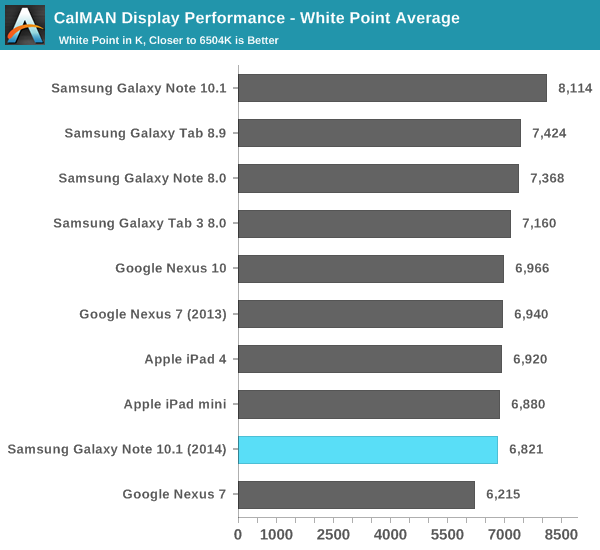
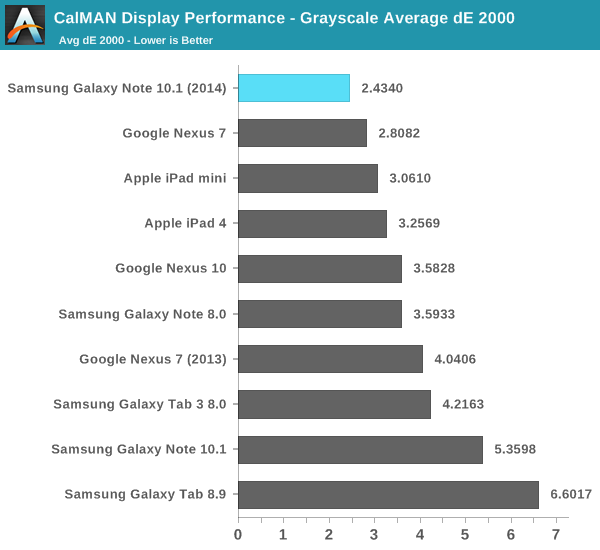
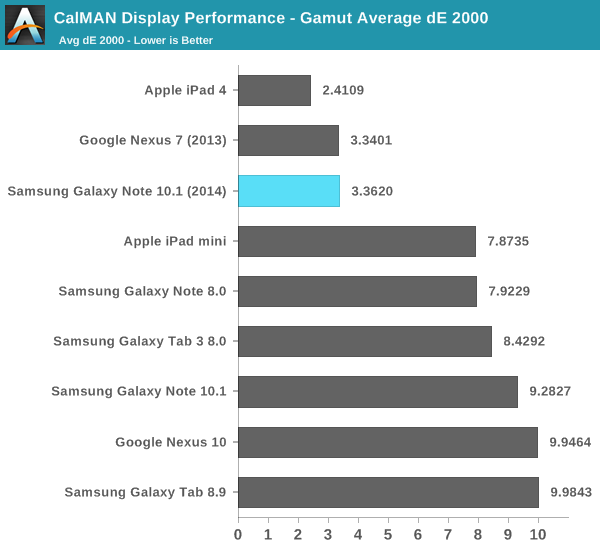
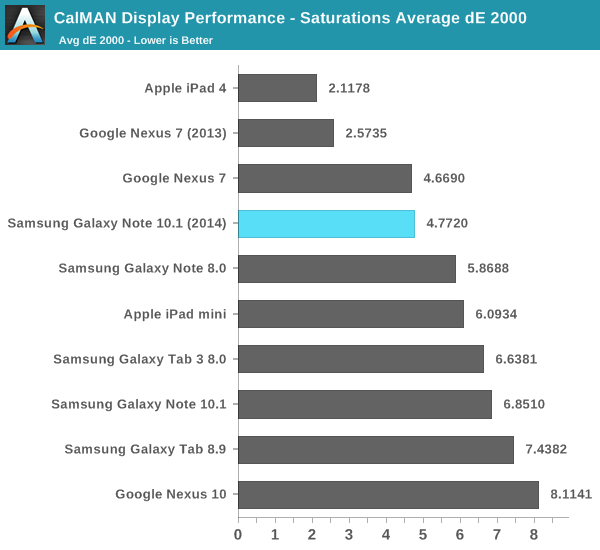
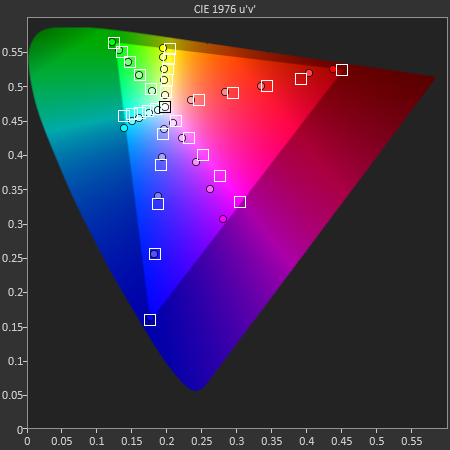
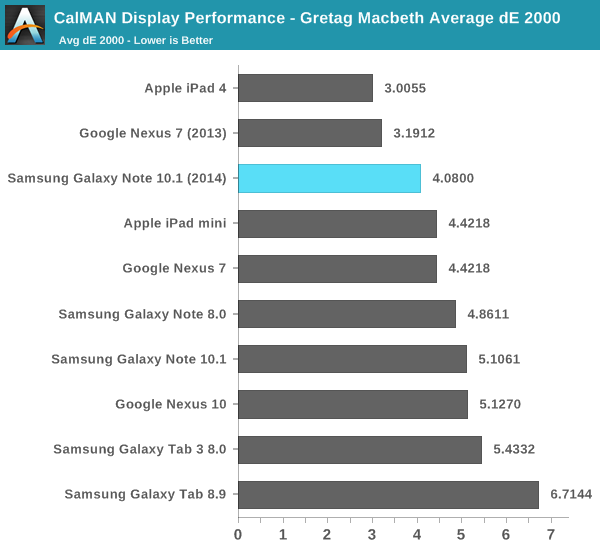

Camera
The 2014 Edition features a rear facing 8MP camera with AF and LED flash and a 2MP front facing camera. Image quality out of the rear camera was pretty good for a tablet. I took some photos using the tablet and tossed them in the gallery below, as well as embedded a sample 1080p video recorded using the tablet.
Battery Life & Charging
The Galaxy Note 10.1 (2014 Edition) ships with an integrated (non-removable) 31Wh battery, that’s substantially smaller than the iPad 4’s 42.5Wh battery - helping it maintain a more svelte figure. The question is how power efficient the combination of RB,GW panel and Exynos 5420 are in combination with one another.
We’ll start with our typical WiFi web browsing battery life test. Here we see a good combination of regular spikes in CPU usage with idle time, hopefully simulating constant, reasonably paced usage.
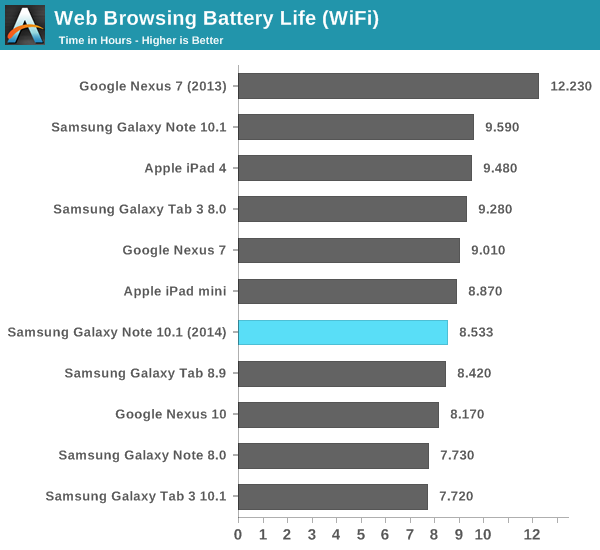
The 2014 Edition does a bit better than the Nexus 10, but clearly worse than the original Note 10.1 (and obviously worse than the much smaller Nexus 7). There’s not much you can do here other than to point out that we’re talking about an extremely high resolution panel, with an extremely power hungry SoC. The fact that we’re talking about more cores running at a higher frequency than the Exynos 5250 used in the Nexus 10 is good news, but Exynos 5420 also enjoys the benefits of being on Samsung’s 28nm LP process as well.
The video playback story is much better however. With the power hungry Cortex A15 cores able to power down (and hopefully remain there), we’re really testing the display and video decode engines here:
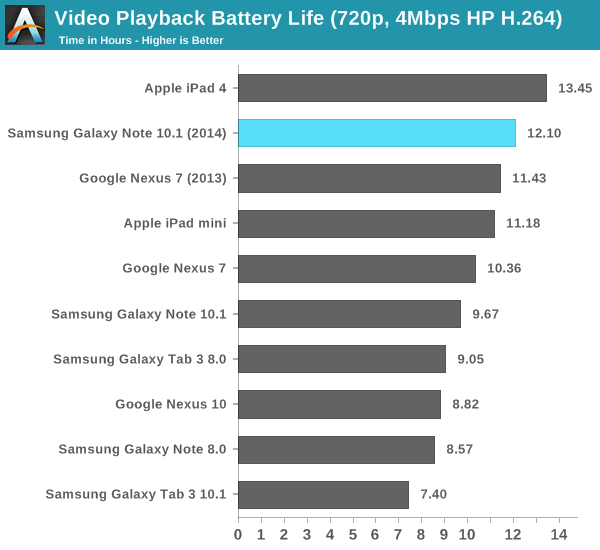
The Note 10.1 beats the new Nexus 7 and is only 10% behind the iPad 4, despite having a much smaller battery.
Like the Nexus 10, the Galaxy Note 10.1 (2014 Edition) takes an incredible amount of time to charge with the bundled 2A charger. A full charge from 0 to 100% took just over 7 hours.
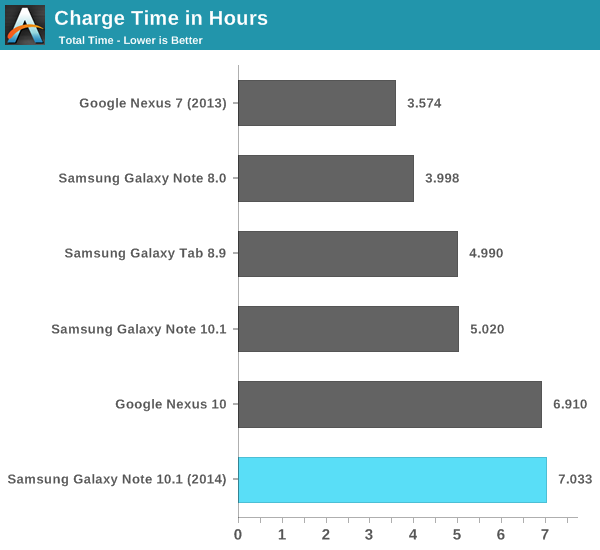
















97 Comments
View All Comments
Diogenes5 - Tuesday, October 1, 2013 - link
So because of some arbitrary benchmark, you want to spend almost $400 dollars more on a device that will get even less support, has a worse resolution, and has even fewer dedicated apps?Ok fanboy, please leave the intelligent community at Anandtech alone and go back to the kiddie pool.
As always, Anandtech provides the best reviews. Looks like I'll be getting one write off the bat. As a student, I've been using last year's Note 10.1 as my daily driver along with LectureNotes and ezPDF. I could really use the upgrade in resolution and cpu/gpu in order to browse through my textbooks more quickly and precisely.
Da W - Tuesday, October 1, 2013 - link
"So because of some arbitrary benchmark, you want to spend almost $400 dollars more on a device that will get even less support, has a worse resolution, and has even fewer dedicated apps?"Looks like you are posting worst fanboy comments than me.
I just said the point that jumped in my face was how good the iPhone's 5s SoC was in the benchmarks, compared to a 10" tablet!
As for the other point, i used a tablet PC since 2000 something, and to that point the Surface Pro is the note-taking tablet perfected, WAY more useful for work or college work with a full office suite. I think MS has that niche covered better than Samsung. (price excluded, but a Baytrail surface pro would be perfect).
Impulses - Tuesday, October 1, 2013 - link
Bay Trail belongs on the regular Surface, and I imagine it'll show up as soon as they give up on RT... But other OEMs are soon gonna be seriously undercutting MS by offering Bay Trail on devices that are sold at the current price point of the original Tegra 3 Surface RT ($350, see ASUS), WITH keyboard dock even. Windows tablets would spread so much quicker if they'd just give up on RT already imo, and started pricing them appropriately (Pro's fine, but Surface's overpriced for what it is and what it's competing with).Da W - Tuesday, October 1, 2013 - link
RT is a long term plan to be platform agnostic. *IF* Windows 8.X sees enough success, *IF* enough developpers build Metro apps for it, *IF* office and other popular windows software are translated to Metro format and *IF* the convergence between widnows phone and windows 8 succeed, then in 2-3 years Microsoft will be free of intel and just pick whatever best SoC the market has to offer at that time. Which may or may not be Intel's.However, in order to do that, Microsoft had to push Windows RT to see widespread adoption, and they had to force Metro down a few peoples' troat in windows 8 desktop. In retrospect, may be they are failling, but they had no choice to do what they did in order to acheive their goal. Otherwise, if intel dies, they die. And yes when you look at the trend, ARM is picking up quickly and charging cheap.
Problem is: they have to improve Metro by a wide margin and open it up. Windows 8.1 is not nearly enough. Then developers need to adapt their software to it.
I'm surprised so few people picked that up.
Diogenes5 - Tuesday, October 1, 2013 - link
Baytrail runs Android just as well as Windows 8.1 if Intel marketing is to be believed. For platform agnostics, if a company can come out with a good baytrail tablet with an active stylus and dual boot with both Android and Windows, then count me in. I'll wait and see if that actually happens though.Diogenes5 - Tuesday, October 1, 2013 - link
Phones often beat tablets all the time. They all use the same SOC's for the most part. Samsung used basically the same Exnyos chips in its Galaxy Note II, Note 8.0 and Note 10.1 2013. Apple did the same with it's dated Ipad 2 chip when it released the Ipad Mini. Saying that the current Iphone 5s chip beats the Note 10.1 2014 really doesn't mean that much to most people. They are about the same speed and the Iphone 5s beats most other devices on the market right now.Congrats for using a tablet PC when Microsoft poorly underserved the market with its bulky form factors, bad battery life, and poor application support in the mid-2000's.
The surface Pro is indeed not perfect. The few people that I knew owned one complained that it ran hot, ran loud sometimes, and had only about 4-5 hour battery life even for in-class note-taking. It's nice that you get a full x86 chip but it also costs twice of what most Android and iOS tablets do. Maybe the Surface Pro 2 will improve upon some of these things. It will probably get about 20-30% more battery life and having a battery in the keyboard dock will help longevity. Unfortunately, 64gb of SSD space (about only half of which will be available) and only 4gb of ram for an OS with much more overhead than Android is not at all impressive for an $899 device.
I, for one, will happily use my galaxy Note 10.1 2014 in class just like I have with my Galaxy Note 10.1 2013 and sync my lecturenotes and pdf's to dropbox for later viewing on my other devices. At half the price and half the headache of a microsoft device.
ESC2000 - Thursday, October 10, 2013 - link
The benchmarks don't tell the full story though since they're running single threaded JS which doesn't allow the note to demonstrate its six-core advantage.djboxbaba - Tuesday, October 1, 2013 - link
"Apps" "Support". Really? surface PRO, aka the full windows environment. Please tell me when you can serious applications on the galaxy note.abazigal - Friday, October 11, 2013 - link
The fact that tablets (be it IOS or Android-based) get touch-optimised apps that were designed from the ground up already gives it the advantage compared to the Surface Pro, which has to contend with desktop apps wholly unsuited to a touch interface.All the computing power in the world means jack squat when your apps suck to use, which in turn ensures that nobody will use it.
eiriklf - Tuesday, October 1, 2013 - link
It says a lot more about safari compared to samsungs browser.